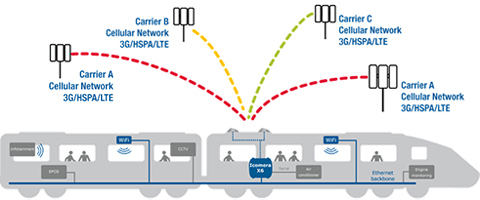Thursday 5 June, 2014, 09:23 - Spectrum Management, Much Ado About Nothing
 Last night’s BBC Watchdog programme discussed the issue of the apparently poor WiFi connectivity available on a number of inter-city train routes across the UK. The programme conducted a survey of the paid-for WiFi service of three long-distance train operators. They measured the percentage of the journey for which a connection was available, and the time it took to download a short file. The average results, together with the current tariffs for WiFi on the three train companies surveyed are shown below.
Last night’s BBC Watchdog programme discussed the issue of the apparently poor WiFi connectivity available on a number of inter-city train routes across the UK. The programme conducted a survey of the paid-for WiFi service of three long-distance train operators. They measured the percentage of the journey for which a connection was available, and the time it took to download a short file. The average results, together with the current tariffs for WiFi on the three train companies surveyed are shown below.| Train Operator | Connection Available | Time To Download A File | Price |
|---|---|---|---|
| Cross-Country | 96.7% | 39 seconds | £2 for 1 hour, £8 for 24 hours |
| East Coast | 79.4% | 13 seconds | £4.95 for 1 hour, £9.95 for 24 hours |
| Virgin Trains | 82.2% | 112 seconds | £4 for 1 hour, £8 for 24 hours |
WiFi services on trains are provided by using antennas on the roof of the trains to connect to mobile networks. These mobile internet connections are then shared amongst all the WiFi users on a train. Companies such as Icomera and Nomad Digital provide boxes that enable multiple mobile internet connections to be combined together to increase the speed of the connection as a single 3G or 4G connection is not going to cut it when shared between multiple WiFi users.

In the programme, self-proclaimed IT Guru Adrian Mars then goes on to explain that the problem with the East Coast and Virgin services is that they make use of the signal from just one mobile operator and share that amongst all the WiFi users on the train, whereas Cross-Country use connections from multiple operators. This would explain why the time for which a connection was available on Cross-Country’s WiFi service was so much higher than on the other two, as they can make use of the overlapping coverage provided by multiple operators.
 It is also true to say that many of the UK’s inter-city train routes pass through very sparsely populated areas, as well as tunnels and deep cuttings, where there is unlikely to be much in the way of a mobile signal. Given the different routes taken by Cross-Country, East Coast and Virgin Trains it is therefore unfair to directly compare them as each route will have a different proportion of these hard-to-get-at areas. 3G and 4G mobile networks also don’t work as well at high speed and (usually) trains travel at speeds that are fast enough to begin to affect performance.
It is also true to say that many of the UK’s inter-city train routes pass through very sparsely populated areas, as well as tunnels and deep cuttings, where there is unlikely to be much in the way of a mobile signal. Given the different routes taken by Cross-Country, East Coast and Virgin Trains it is therefore unfair to directly compare them as each route will have a different proportion of these hard-to-get-at areas. 3G and 4G mobile networks also don’t work as well at high speed and (usually) trains travel at speeds that are fast enough to begin to affect performance.Where the Watchdog’s IT guru did go astray was to suggest that it might be better for train passengers to rely on the connection to their own mobile phone for internet rather than the on-train WiFi. Why is this wrong? There are two main reasons. Firstly, the antennas used by the on-train WiFi systems are mounted on the train roof, whereas your phone will be lower down, inside the carriage. A previous Wireless Waffle article highlighted the need to get high to improve reception and the signal on the roof of the train will be bigger than that inside by dint of this fact alone.
But there is a much bigger problem… trains are typically constructed of metal. Some, including Virgin Trains’ Pendolino trains, have metallised windows. Passengers are thus enclosed in a Faraday cage which will do a grand job of stopping any signals on the outside of the carriages from making their way into the carriages. According to a paper written by consultants Mott MacDonald for Ofcom:
In modern trains the attenaution[sic] can be up to -30dB.
This means that of the signal presented to the outside of the carriage, only one thousandth of it makes it inside the carriage. Add this immense loss to the difference in height between the roof-mounted antenna and you sat in the carriage and it becomes apparent why using your own phone is highly unlikely to yield a better connection than that available through the on-train WiFi.
 The Watchdog team suggested that due to the poor quality of the on-board WiFi it should be offered for free instead of making passengers pay. Many fare-paying train passengers would no doubt express a lot of sympathy with this suggestion. The cost to the rail companies of doing this is not trivial. East Coast, it was claimed, are upgrading their on-board WiFi to the tune of £2 million which compared to the paltry £7m profit they made in 2012/13 is quite a bite. But given the choice of free sandwiches (whose quality is as notoriously dubious as that of the WiFi connection) or free WiFi, most would surely prefer to enhance their digital diet instead of their gastronomic girth.
The Watchdog team suggested that due to the poor quality of the on-board WiFi it should be offered for free instead of making passengers pay. Many fare-paying train passengers would no doubt express a lot of sympathy with this suggestion. The cost to the rail companies of doing this is not trivial. East Coast, it was claimed, are upgrading their on-board WiFi to the tune of £2 million which compared to the paltry £7m profit they made in 2012/13 is quite a bite. But given the choice of free sandwiches (whose quality is as notoriously dubious as that of the WiFi connection) or free WiFi, most would surely prefer to enhance their digital diet instead of their gastronomic girth. 